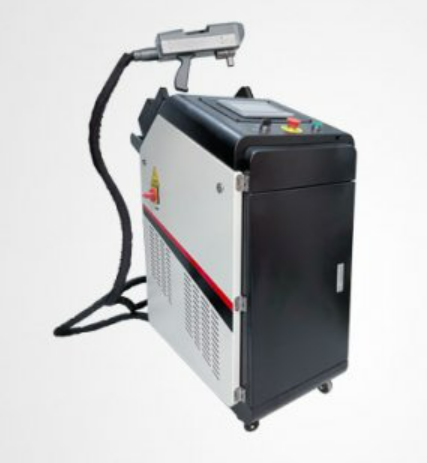Laser cleaning is a process used to safely remove paint, rust, or other undesired contaminants from various surfaces. In this blog post we will discuss the technology, uses, and benefits of modern Handheld Laser Cleaning Machines.
Introduction to Laser Cleaning Technology
Standard laser cleaning technology involves directing pulses of laser light towards a surface in order to remove undesired materials. These pulses are minuscule in length, lasting only a nano-second, or one billionth of a second. Once the laser interacts with the contaminants on the surface the particles melt and evaporate into a gas. Alternatively, the intense pressure of the laser will simply remove the contaminant in small particles from the surface.
Laser cleaning machines typically require a pulsed fiber laser to function, typically of about 50 watts or more. For more powerful cleaning needs, consider using a 300w pulse laser cleaning machine. Pulsed lasers do not emit light and radiation in a consistent manner, but rather release optical pulses. With the right parameters, these laser pulses only impact the grime on the surface, keeping the material safe and cool underneath. Protection of the underlying material is critical in this process since it is primarily used to refurbish previously used objects. Metaphorically, the overall procedure can be compared to removing a layer of paint without causing damage to the base coat.
Once undesired contaminants are removed from the material, any resulting airborne gas or dust is collected through a fume extraction unit. For a better visual understanding of how this process works and what it looks like, you can watch the video below.
Applications of Laser Cleaning
Laser cleaners can be used in a wide variety of scenarios ranging from large-scale to at-home projects. As long as the settings and equipment can be changed in accordance with materials, laser cleaners are extremely effective in any environment. Smaller projects could include removing dirt and bacteria from delicate surfaces like marble, granite, concrete, or limestone as found in your home. A larger project entails the removal of copious amounts of contaminants, such as removing rust from a worn ship.
They also prove exceedingly useful in the cleaning of molds/casts involved in production lines. This manufacturing method involves shaping a liquid or other malleable material using a fixed frame. These molds or fixed frames are primarily made of metal, making them easy candidates for laser cleaning. A clean mold ensures that any paints or other materials adhere well to the created part. Without a clean and exact surface, production line molds could prove faulty and fail in providing quality parts.
The types of projects that laser cleaners are used for exhibit their array of strengths. Removing rust from massive objects requires immense power while removing dirt from delicate materials requires precision and care. Although these circumstances would call for different types of laser cleaners or alternate machines, it showcases the successes of the overall technology.
Handheld Laser Cleaners
The technology of handheld laser cleaners is identical to that of traditional laser cleaners, so what’s the difference? Handheld laser options optimize your mobility during the cleaning process. Allowing the user to adjust their angle and line of sight with ease. The handheld alternative permits flexibility for location changes, meaning you can easily choose which spots of the object to clean in your desired sequence. A typical handheld laser cleaner is depicted in the photo below.

Mid-Low Power Handheld Pulsed Laser Cleaning Machine HCP-C200
Projects that can be completed with Handheld Laser Cleaners
As stated previously, laser cleaners can be used for a variety of projects. With a wide range of material capabilities, there are a few limitations. In the past decade, these advantages have also caught the attention of museum artifact conservators. These are the individuals who treat, manage and preserve historical artifacts in museums.
Handheld Laser Cleaners have become crucial machines that contribute to the upkeep and preservation of numerous historical objects, some of which are known around the world. The renowned Parthenon Marbles have become examples of these technological successes, standing proud in the Acropolis Museum in Athens, Greece. The marbles shown below are on exhibit in Athens.

Laser Cleaned Caryatid- Greek Marble
The preservation of these marbles is important in historical documentation and archeological research, so their good condition must be carefully maintained. Recently, the Acropolis Museum has utilized handheld laser cleaners to do so. The advanced laser technology is able to remove built-up contaminants of modern pollution on the sculptures, while also uncovering colors and carvings that have been hidden for decades. The cleaning of an acropolis sculpture is shown in the video below, with a Caryatid statue (shown in the photo above) as the subject.
Advantages and Disadvantages of Laser Cleaning Machines
Benefits
There is a seemingly endless list of benefits to Laser Cleaners aside from their cleaning capabilities. They are easy to operate for complex machines, as they are very user-friendly. Both safe and reliable, they are capable of removing contaminants whilst also leaving the underlying material untouched. They are quiet and easily automated, making them perfect machines for a variety of workspaces. The machines call for very little cleanup and maintenance, making them extremely efficient with very low operating costs. The machine will escalate energy savings in comparison to conventional methods.
Limitations
Although Laser Cleaners are extremely versatile, there are still a few limitations as to what materials they are compatible with. To start, the underlying material cannot be too reflective. If the material is reflective, there will be no heat imposed upon the contaminant, and therefore it cannot be removed. It has also been found that the cleaners will only work on the following materials:
- Stone
- Plastics
- Composites
- Wood
- Steel
- Cast Iron
- Aluminum
- Stone/Marble
- Glass
Environmental Impact
In what is hopefully becoming a more environmentally conscious world, Laser Cleaners are the perfect machines for eco-friendly cleaning. They offer a unique alternative to previous methods that would use mechanical and chemical processes. These methods would release greenhouse gasses that are catastrophic for Earth’s atmosphere, and produce a potentially toxic waste that would later prove harmful to water supplies.
Laser Cleaners are a perfect choice for a chemical-free process with clean waste disposal. Not only are they safe for the environment, but they exhibit user-friendly traits for safe user execution. Hopefully, with the advancement of this technology in the coming years, we can see the capabilities of these machines reach their full potential.
